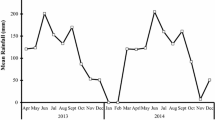Abstract
Several studies assessing the effect of leguminous tree biomass such as Gliricidia sepium and Tephrosia vogelii on maize yield have been undertaken. There has been limited knowledge on the efficacy of leguminous tree biomass on maize yield when grown after a crop with a high nitrogen (N) demand. One such crop is cotton. The current study was undertaken with the objective of determining the efficacy of either gliricidia or tephrosia biomass application with or without inorganic fertilizer on maize yield cultivated after cotton and also after land fallowing. Significant variations in grain yield (P = 0.0038) were obtained in the second cropping season (2016/17) but not in the first cropping season (2014/15), except maize stover (P < 0.0016). Significant variations were also obtained during 2016/17 season with respect to maize cob yield (P < 0.0041) and stover yield (P = 0.0062). Grain yield was significantly higher where inorganic fertilizer was applied with gliricidia biomass than where inorganic fertilizer was applied alone. A similar trend was also observed during the first cropping season though not significantly different. Lower grain yield was obtained when cotton crop preceded maize crop indicating a need for a higher N fertilizer dose for maize crop cultivated after cotton. Application of a half dose of inorganic fertilizer together with gliricidia biomass showed high and steady grain yield over the yield obtained when inorganic fertilizer was applied alone. It is concluded that soil fertility amendment with inorganic fertilizer is needed after a cotton crop. Also, the use of a half dose of inorganic N fertilizer with gliricidia was effective, suggesting that a full dose with gliricidia biomass was rather surplus to the requirements for maize production. Our study shows that farmers can save nearly half of the inorganic N fertilizer required by maize under gliricidia-maize system.




Similar content being viewed by others
References
Akinnifesi FK, Kwesiga FR, Mhango J, Mkonda A, Chilanga T, Swai R (2004) Domesticating priority miombo indigenous fruit trees as a promising livelihood option for smallholder farmers in southern Africa. Acta Hort 632:15–30
Akinnifesi FK, Makumba W, Kwesiga FR (2006) Sustainable maize production using gliricidia/maize intercropping in southern Malawi. Expl Agric 42:1–17
Akinnifesi FK, Makumba W, Sileshi G, Ajayi OC, Mweta D (2007) Synergistic effect of inorganic N and P fertilizers and organic inputs from Gliricidia sepium on productivity of intercropped maize in southern Malawi. Plant Soil 294:203–217
Akinnifesi FK, Sileshi G, Franzel S, Ajayi OC, Harawa R, Makumba W, Chakeredza S, Mng’omba S, de Wolf JJ, Chianu JN (2009) On-farm assessment of legume fallows and other soil fertility management options used by smallholder farmers in southern Malawi. Agric J 4(6):260–271
Akinnifesi FK, Ajayi OC, Sileshi G, Chirwa P, Chianu J (2010) Fertilizer trees for sustainable food security in the maize-based production systems of East and Southern Africa region: a review. Agron Sustain Dev 30:615–629
Beedy LT, Snapp SS, Akinnifesi FK, Sileshi GW (2010) Impact of Gliricidia sepium intercropping on soil organic matter fractions in a maize-based cropping system. Agric Ecosyst Environ 138:139–146
Hou Z, Li P, Li B, Gong J, Wang Y (2007) Effects of fertigation scheme on N uptake and N use efficiency in cotton. Plant Soil 290:115–126
Ikerra ST, Maghembe JA, Smithson PC, Buresh RJ (1999) Soil nitrogen dynamics and relationships with maize yields in a Gliricidia-maize intercrop in Malawi. Plant Soil 211:155–164
Mafongoya PL, Chintu R, Chirwa TS, Matibini J, Chikale S (2003) Tephrosia species and provenances for improved fallows in southern Africa. Agrofor Syst 59:279–288
Makumba W (2003) Nitrogen use efficiency and carbon sequestration in legume tree-based agroforestry systems. A case study in Malawi. Wageningen University and Research Center, Wageningen, The Netherlands
Makumba W, Janssen B, Oenema O, Akinnifesi FK (2005) Influence of time of application on the performance of Gliricidia prunings as a source of N for maize. Exp Agric 42:1–17
Makumba W, Akinnifesi FK, Janssen BH (2009) Spatial rooting patterns of gliricidia, pigeon pea and maize intercrops and effect on profile soil N and P distribution in southern Malawi. J Agric Res 4(4):278–288
Mng’omba SA, Akinnifesi FK, Kerr A, Salipira K, Muchugi A (2017) Growth and yield responses of cotton (Gossypium hirsutum) to inorganic and organic fertilizers in southern Malawi. Agroforest Syst 91:249–258. https://doi.org/10.1007/s10457-016-9924-0
Munthali MG, Charles KK, Gachene CKK, Sileshi GW, Karanja NK (2014) Amendment of tephrosia improved fallows with inorganic fertilizers improves soil chemical properties, N uptake, and maize yield in Malawi. Int J Agron 2014:1–9. https://doi.org/10.1155/2014/902820
Primo DC, Menezes RSC, Sampaio EVDSB, da Silva Garrido M, Júnior JCBD, Souza CS (2014) Recovery of N applied as 15 N-manure or 15 N-gliricidia biomass by maize, cotton and cowpea. Nutr Cycl Agroecosyst 100:205–214
SAS Institute Inc (2000) SAS/STAT user’s guide, version 8. SAS Institute Inc., Cary
Sileshi GW, Debusho LK, Akinnifesi FK (2012) Can integration of tree legumes increase yield stability in rainfed maize cropping systems in southern Africa. Agron J 104:1–7
Smethurst PJ, Huth NI, Masikati P, Sileshi GW, Akinnifesi FK, Wilson J, Sinclair F (2017) Accurate crop yield predictions from modelling tree-crop interactions in gliricidia-maize agroforestry. Agric Syst 155:70–77
Stewart WM (2000) Fertilize cotton for optimal yield and quality. A regional newsletter published by the Potash and Phosphate Institute (PPI), Canada. www.ipni.net/ppiweb/ppinews.nsf. Accessed 30 Mar 2016
Zaharah AR, Bah AR (1999) Patterns of decomposition and nutrient release by fresh Gliricidia (Gliricidia sepium) leaves in an ultisol. Nutr Cycl Agroecosyst 55:269–277
Acknowledgements
The authors acknowledge the financial support from the field genebank for southern Africa. We also acknowledge technical support from Mr. Chiku Kwakwala for managing the trials.
Author information
Authors and Affiliations
Corresponding author
Additional information
Publisher's Note
Springer Nature remains neutral with regard to jurisdictional claims in published maps and institutional affiliations.
Rights and permissions
About this article
Cite this article
Mng’omba, S.A., Akinnifesi, F.K. Effect of soil amendment with Gliricidia sepium and Tephrosia vogelii biomass on maize yield at Makoka in Malawi. Agroforest Syst 94, 441–449 (2020). https://doi.org/10.1007/s10457-019-00405-4
Received:
Accepted:
Published:
Issue Date:
DOI: https://doi.org/10.1007/s10457-019-00405-4




